child seat MITSUBISHI TRITON 2011 Owners Manual
[x] Cancel search | Manufacturer: MITSUBISHI, Model Year: 2011, Model line: TRITON, Model: MITSUBISHI TRITON 2011Pages: 369, PDF Size: 26.15 MB
Page 37 of 369
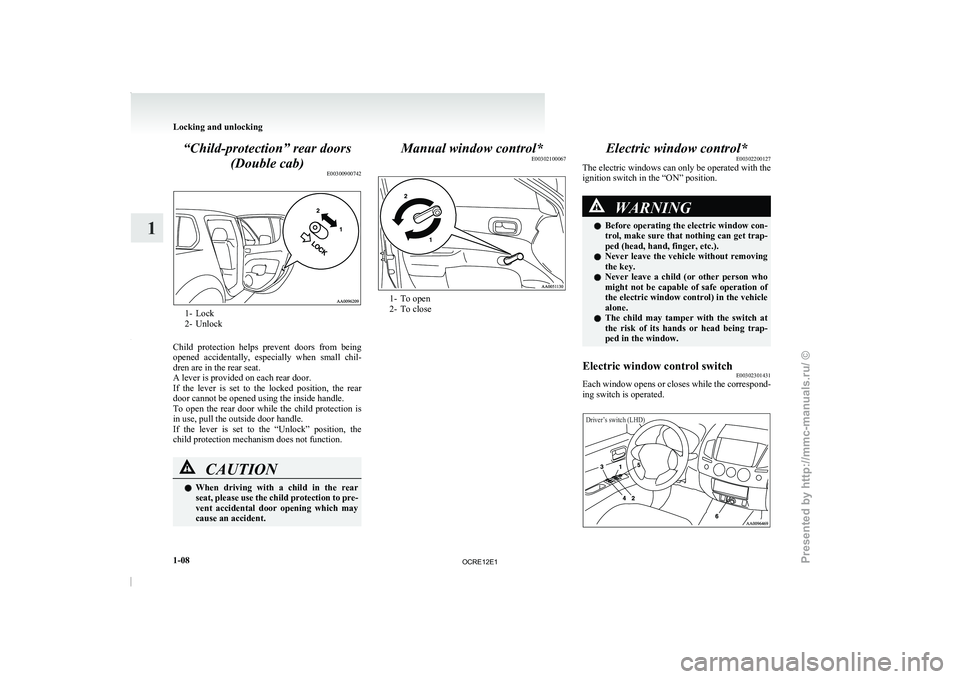
“Child-protection” rear doors
(Double cab) E003009007421- Lock
2- Unlock
Child protection helps prevent
doors from being
opened accidentally, especially when small chil-
dren are in the rear seat.
A lever is provided on each rear door.
If the lever is set to the locked position, the rear
door cannot be opened using the inside handle.
To open the rear door while the child protection is
in use, pull the outside door handle.
If the lever is set to the “Unlock” position, the
child protection mechanism does not function. CAUTION
l
When driving with a
child
in the rear
seat, please use the child protection to pre-
vent accidental door opening which may
cause an accident. Manual window control*
E00302100067 1- To open
2- To close
Electric window control*
E00302200127
The electric windows can only be operated with the
ignition switch in the “ON” position. WARNING
l Before operating the electric
window
con-
trol, make sure that nothing can get trap-
ped (head, hand, finger, etc.).
l Never leave the vehicle without removing
the key.
l Never leave a child (or other person who
might not be capable of safe operation of
the electric window control) in the vehicle
alone.
l The child may tamper with the switch at
the risk of its hands or head being trap-
ped in the window.
Electric window control switch E00302301431
Each window opens or closes while the correspond-
ing switch is operated.
Driver’s switch (LHD) Locking and unlocking
1-08
1
OCRE12E1
Presented by http://mmc-manuals.ru/ \251
Page 46 of 369
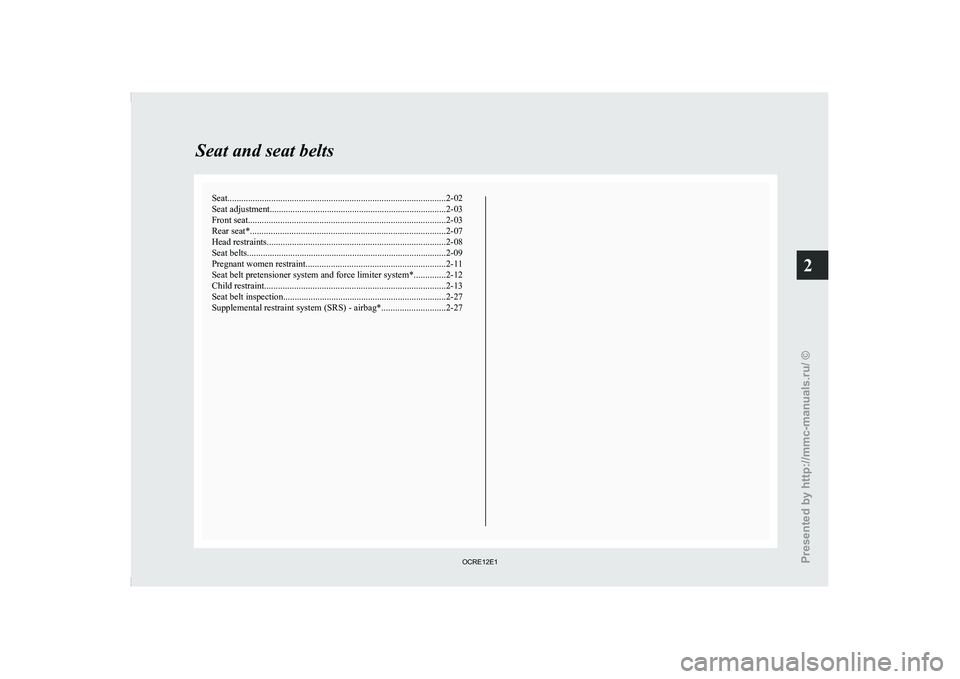
Seat...............................................................................................
2-02
Seat adjustment ............................................................................. 2-03
Front seat...................................................................................... 2-03
Rear seat* ..................................................................................... 2-07
Head restraints .............................................................................. 2-08
Seat belts .......................................................................................2-09
Pregnant women restraint ............................................................. 2-11
Seat belt pretensioner system and force limiter system* ..............2-12
Child restraint ............................................................................... 2-13
Seat belt inspection ....................................................................... 2-27
Supplemental restraint system (SRS) - airbag* ............................2-27Seat and seat belts
2
OCRE12E1
Presented by http://mmc-manuals.ru/ \251
Page 48 of 369
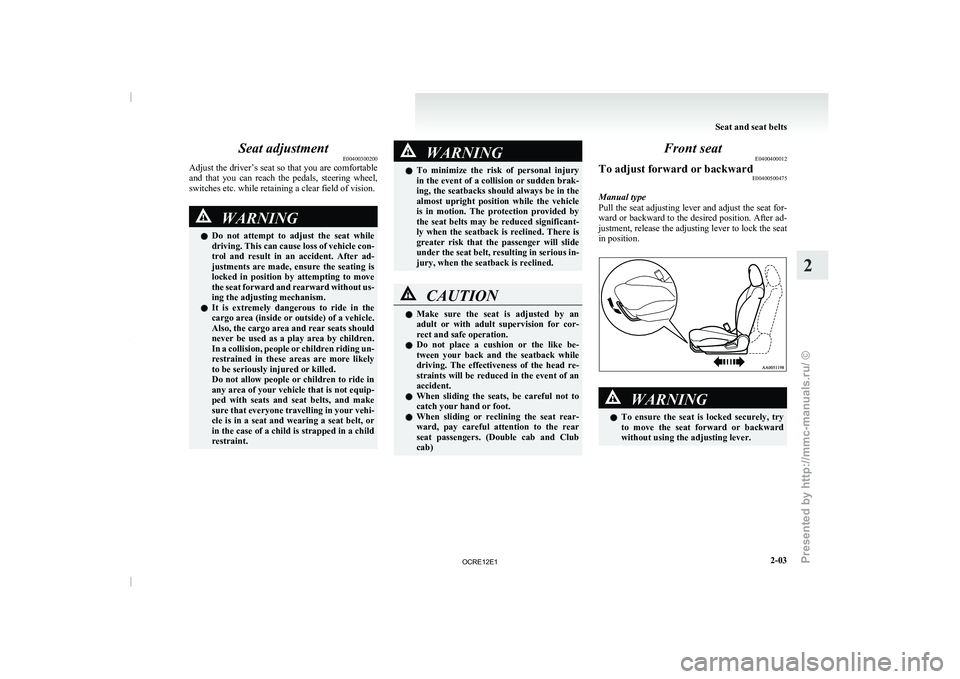
Seat adjustment
E00400300200
Adjust the driver’s seat so
that you are comfortable
and that you can reach the pedals, steering wheel,
switches etc. while retaining a clear field of vision. WARNING
l Do not attempt to
adjust
the seat while
driving. This can cause loss of vehicle con-
trol and result in an accident. After ad-
justments are made, ensure the seating is
locked in position by attempting to move
the seat forward and rearward without us-
ing the adjusting mechanism.
l It is extremely dangerous to ride in the
cargo area (inside or outside) of a vehicle.
Also, the cargo area and rear seats should
never be used as a play area by children.
In a collision, people or children riding un-
restrained in these areas are more likely
to be seriously injured or killed.
Do not allow people or children to ride in
any area of your vehicle that is not equip-
ped with seats and seat belts, and make
sure that everyone travelling in your vehi-
cle is in a seat and wearing a seat belt, or
in the case of a child is strapped in a child
restraint. WARNING
l To minimize the risk of
personal injury
in the event of a collision or sudden brak-
ing, the seatbacks should always be in the
almost upright position while the vehicle
is in motion. The protection provided by
the seat belts may be reduced significant-
ly when the seatback is reclined. There is
greater risk that the passenger will slide
under the seat belt, resulting in serious in-
jury, when the seatback is reclined. CAUTION
l
Make
sure the
seat is
adjusted by an
adult or with adult supervision for cor-
rect and safe operation.
l Do not place a cushion or the like be-
tween your back and the seatback while
driving. The effectiveness of the head re-
straints will be reduced in the event of an
accident.
l When sliding the seats, be careful not to
catch your hand or foot.
l When sliding or reclining the seat rear-
ward, pay careful attention to the rear
seat passengers. (Double cab and Club
cab) Front seat
E0400400012
To adjust forward or backward E00400500475
Manual type
Pull the seat
adjusting lever
and adjust the seat for-
ward or backward to the desired position. After ad-
justment, release the adjusting lever to lock the seat
in position. WARNING
l To ensure the seat
is
locked securely, try
to move the seat forward or backward
without using the adjusting lever. Seat and seat belts
2-03 2
OCRE12E1
Presented by http://mmc-manuals.ru/ \251
Page 51 of 369
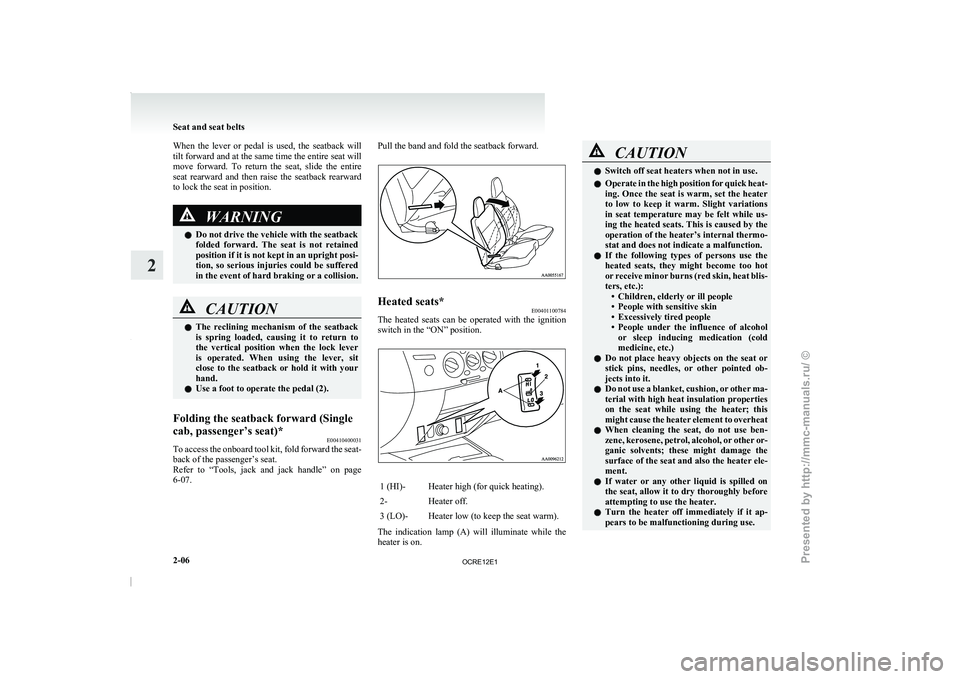
When the lever or pedal is used, the seatback will
tilt forward and at the
same time the entire seat will
move forward. To return the seat, slide the entire
seat rearward and then raise the seatback rearward
to lock the seat in position. WARNING
l Do not drive the vehicle with the seatback
folded forward. The seat
is
not retained
position if it is not kept in an upright posi-
tion, so serious injuries could be suffered
in the event of hard braking or a collision. CAUTION
l
The reclining mechanism of the
seatback
is spring loaded, causing it to return to
the vertical position when the lock lever
is operated. When using the lever, sit
close to the seatback or hold it with your
hand.
l Use a foot to operate the pedal (2).
Folding the seatback forward (Single
cab, passenger’s seat)* E00410400031
To access the onboard tool kit, fold forward the seat-
back of the passenger’s seat.
Refer to “Tools, jack and
jack handle” on page
6-07. Pull the band and fold the seatback forward.
Heated seats*
E00401100784
The heated seats can be operated with the ignition
switch in the “ON” position. 1 (HI)- Heater high (for quick heating).
2- Heater off.
3 (LO)- Heater low (to keep the seat warm).
The indication lamp (A) will illuminate while the
heater is on. CAUTION
l
Switch off seat heaters when not in use.
l Operate in the high position
for quick heat-
ing. Once the seat is warm, set the heater
to low to keep it warm. Slight variations
in seat temperature may be felt while us-
ing the heated seats. This is caused by the
operation of the heater’s internal thermo-
stat and does not indicate a malfunction.
l If the following types of persons use the
heated seats, they might become too hot
or receive minor burns (red skin, heat blis-
ters, etc.):
• Children, elderly or ill people
• People with sensitive skin
• Excessively tired people
• People under the influence of alcoholor sleep inducing medication (cold
medicine, etc.)
l Do not place heavy objects on the seat or
stick pins, needles, or other pointed ob-
jects into it.
l Do not use a blanket, cushion, or other ma-
terial with high heat insulation properties
on the seat while using the heater; this
might cause the heater element to overheat
l When cleaning the seat, do not use ben-
zene, kerosene, petrol, alcohol, or other or-
ganic solvents; these might damage the
surface of the seat and also the heater ele-
ment.
l If water or any other liquid is spilled on
the seat, allow it to dry thoroughly before
attempting to use the heater.
l Turn the heater off immediately if it ap-
pears to be malfunctioning during use. Seat and seat belts
2-06
2
OCRE12E1
Presented by http://mmc-manuals.ru/ \251
Page 54 of 369
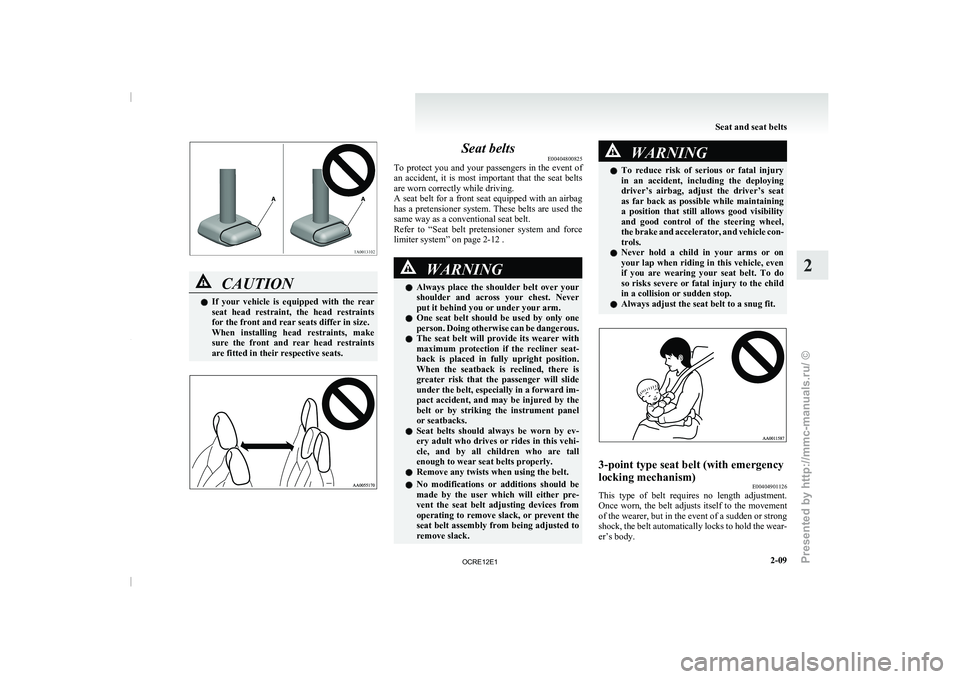
CAUTION
l
If your vehicle is
equipped with the rear
seat head restraint, the head restraints
for the front and rear seats differ in size.
When installing head restraints, make
sure the front and rear head restraints
are fitted in their respective seats. Seat belts
E00404800825
To protect you and your
passengers in the event of
an accident, it is most important that the seat belts
are worn correctly while driving.
A seat belt for a front seat equipped with an airbag
has a pretensioner system. These belts are used the
same way as a conventional seat belt.
Refer to “Seat belt pretensioner system and force
limiter system” on page 2-12 . WARNING
l Always place the shoulder
belt
over your
shoulder and across your chest. Never
put it behind you or under your arm.
l One seat belt should be used by only one
person. Doing otherwise can be dangerous.
l The seat belt will provide its wearer with
maximum protection if the recliner seat-
back is placed in fully upright position.
When the seatback is reclined, there is
greater risk that the passenger will slide
under the belt, especially in a forward im-
pact accident, and may be injured by the
belt or by striking the instrument panel
or seatbacks.
l Seat belts should always be worn by ev-
ery adult who drives or rides in this vehi-
cle, and by all children who are tall
enough to wear seat belts properly.
l Remove any twists when using the belt.
l No modifications or additions should be
made by the user which will either pre-
vent the seat belt adjusting devices from
operating to remove slack, or prevent the
seat belt assembly from being adjusted to
remove slack. WARNING
l To reduce risk of serious
or fatal injury
in an accident, including the deploying
driver’s airbag, adjust the driver’s seat
as far back as possible while maintaining
a position that still allows good visibility
and good control of the steering wheel,
the brake and accelerator, and vehicle con-
trols.
l Never hold a child in your arms or on
your lap when riding in this vehicle, even
if you are wearing your seat belt. To do
so risks severe or fatal injury to the child
in a collision or sudden stop.
l Always adjust the seat belt to a snug fit. 3-point type seat belt (with emergency
locking mechanism)
E00404901126
This type of belt requires no length adjustment.
Once worn, the belt adjusts
itself to the movement
of the wearer, but in the event of a sudden or strong
shock, the belt automatically locks to hold the wear-
er’s body. Seat and seat belts
2-09 2
OCRE12E1
Presented by http://mmc-manuals.ru/ \251
Page 56 of 369
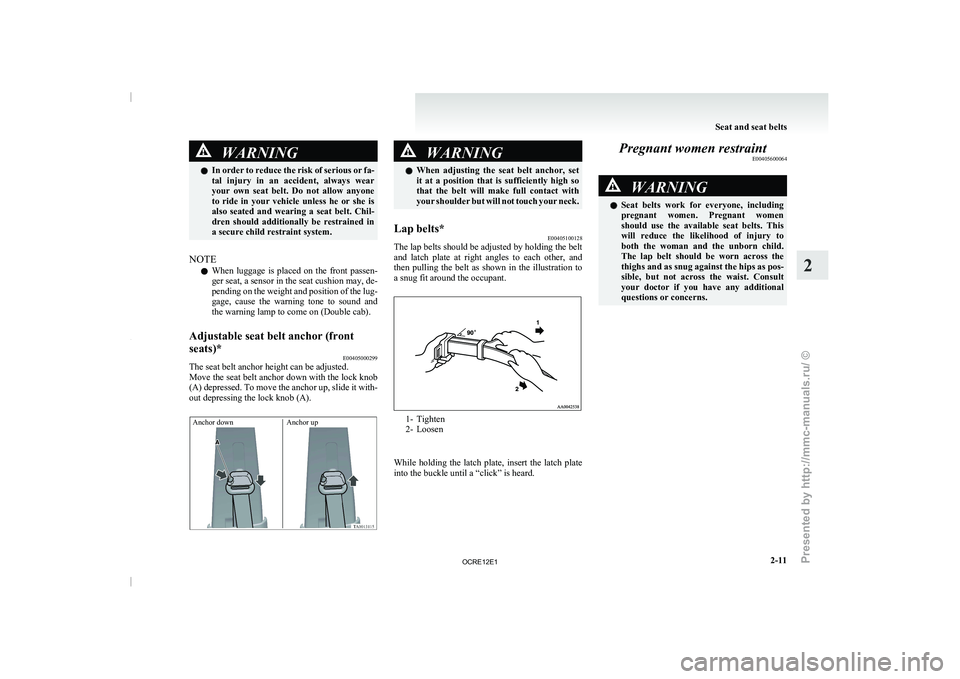
WARNING
l In order to reduce the risk of serious or fa-
tal injury in an accident, always wear
your own seat belt. Do not allow anyone
to ride in your vehicle unless he or she is
also seated and wearing a seat belt. Chil-
dren should additionally be restrained in
a secure child restraint system.
NOTE l When
luggage is placed on
the front passen-
ger seat, a sensor in the seat cushion may, de-
pending on the weight and position of the lug-
gage, cause the warning tone to sound and
the warning lamp to come on (Double cab).
Adjustable seat belt anchor (front
seats)* E00405000299
The seat belt anchor height can be adjusted.
Move the seat belt anchor
down with the lock knob
(A) depressed. To move the anchor up, slide it with-
out depressing the lock knob (A).
Anchor down Anchor up WARNING
l When adjusting the seat belt
anchor, set
it at a position that is sufficiently high so
that the belt will make full contact with
your shoulder but will not touch your neck.
Lap belts* E00405100128
The lap belts should be adjusted by holding the belt
and latch plate
at right
angles to each other, and
then pulling the belt as shown in the illustration to
a snug fit around the occupant. 1- Tighten
2- Loosen
While holding the latch
plate, insert the latch plate
into the buckle until a “click” is heard. Pregnant women restraint
E00405600064 WARNING
l Seat belts work for
everyone,
including
pregnant women. Pregnant women
should use the available seat belts. This
will reduce the likelihood of injury to
both the woman and the unborn child.
The lap belt should be worn across the
thighs and as snug against the hips as pos-
sible, but not across the waist. Consult
your doctor if you have any additional
questions or concerns. Seat and seat belts
2-11 2
OCRE12E1
Presented by http://mmc-manuals.ru/ \251
Page 58 of 369

Child restraint
E00406401297
When transporting children in your
vehicle, some
type of child restraint system should always be
used according to the size of the child. This is re-
quired by law in most countries.
The regulations concerning driving with children in
the front seat may differ from country to country.
You are advised to comply with the relevant regula-
tions. WARNING
l When possible, put children
in
the rear
seat. Accident statistics indicate that chil-
dren of all sizes and ages are safer when
properly restrained in the rear seat rath-
er than in the front seat. (Double cab and
Club cab)
l Holding a child in your arms is no substi-
tute for a restraint system. Failure to use
a proper restraint system can result in se-
vere or fatal injury to the child.
l Each child restraint device or fixing is to
be used only by one child.
l When attaching a child restraint to the
rear seat, place the front seatbacks in the
upright position.
Otherwise, the child could be seriously in-
jured in the event of hard braking or a col-
lision. (Double cab and Club cab) Caution for installing the child re-
straint on vehicles with a front passen-
ger airbag
E00406500190
The label shown here is
attached on vehicles with a
front passenger airbag. WARNING
l Extreme Hazard!
Do not use a
rearward
facing child re-
straint on a seat protected by an airbag in
front of it!
l A REARWARD FACING CHILD RE-
STRAINT must NOT be used in the front
passenger seat if the front passenger’s air-
bag has not been deactivated. The force
of an inflating airbag could kill or cause
serious injuries to the child.
Front passenger’s airbag ON NOTE
l If
you have a rearward
facing child restraint
system that cannot be fitted to any seat other
than the front passenger seat, be sure to turn
OFF the front passenger’s airbag ON-OFF
switch before using it. (Refer to “To turn an
airbag off” on page 2-30.)
Front passenger’s airbag OFF Seat and seat belts
2-13 2
OCRE12E1
Presented by http://mmc-manuals.ru/ \251
Page 59 of 369
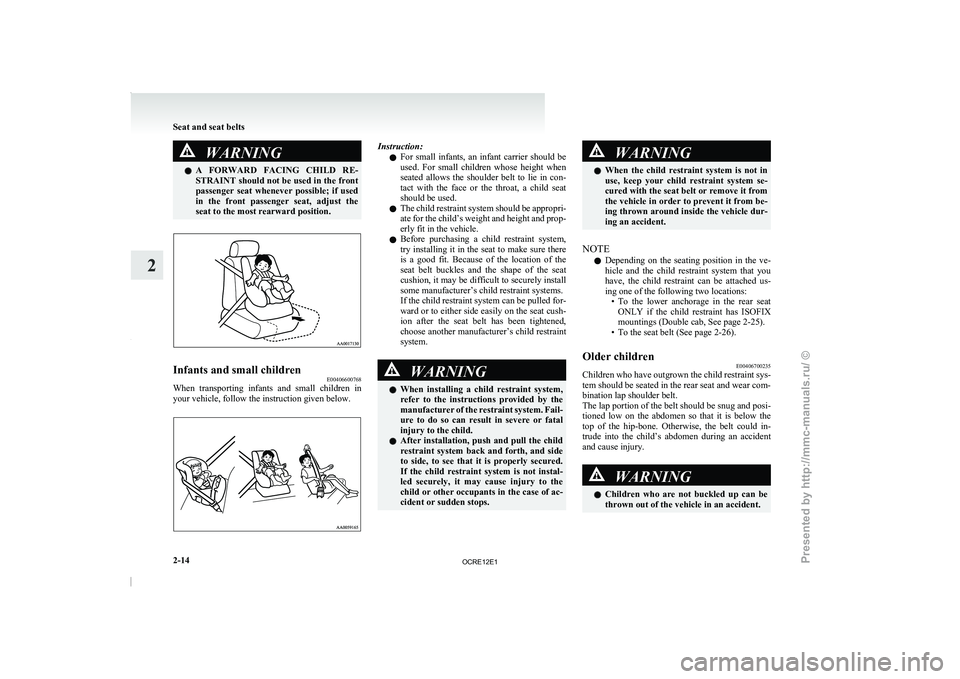
WARNING
l A FORWARD FACING CHILD RE-
STRAINT should not be used in the front
passenger seat whenever possible; if used
in the front passenger seat, adjust the
seat to the most rearward position. Infants and small children
E00406600768
When transporting infants and small children in
your vehicle, follow the instruction given below. Instruction:
l For small infants, an infant
carrier should be
used. For small children whose height when
seated allows the shoulder belt to lie in con-
tact with the face or the throat, a child seat
should be used.
l The child restraint system should be appropri-
ate for the child’s weight and height and prop-
erly fit in the vehicle.
l Before purchasing a child restraint system,
try installing it in the seat to make sure there
is a good fit. Because of the location of the
seat belt buckles and the shape of the seat
cushion, it may be difficult to securely install
some manufacturer’s child restraint systems.
If the child restraint system can be pulled for-
ward or to either side easily on the seat cush-
ion after the seat belt has been tightened,
choose another manufacturer’s child restraint
system. WARNING
l When installing a child
restraint
system,
refer to the instructions provided by the
manufacturer of the restraint system. Fail-
ure to do so can result in severe or fatal
injury to the child.
l After installation, push and pull the child
restraint system back and forth, and side
to side, to see that it is properly secured.
If the child restraint system is not instal-
led securely, it may cause injury to the
child or other occupants in the case of ac-
cident or sudden stops. WARNING
l When the child restraint system
is not in
use, keep your child restraint system se-
cured with the seat belt or remove it from
the vehicle in order to prevent it from be-
ing thrown around inside the vehicle dur-
ing an accident.
NOTE l Depending
on the seating position
in the ve-
hicle and the child restraint system that you
have, the child restraint can be attached us-
ing one of the following two locations: • To the lower anchorage in the rear seatONLY if the child restraint has ISOFIX
mountings (Double cab, See page 2-25).
• To the seat belt (See page 2-26).
Older children E00406700235
Children who have outgrown the child restraint sys-
tem should be seated in the rear seat and wear com-
bination lap shoulder belt.
The lap portion of the belt should be snug and posi-
tioned low on the abdomen
so that it is below the
top of the hip-bone. Otherwise, the belt could in-
trude into the child’s abdomen during an accident
and cause injury. WARNING
l Children who are not
buckled
up can be
thrown out of the vehicle in an accident. Seat and seat belts
2-14
2
OCRE12E1
Presented by http://mmc-manuals.ru/ \251
Page 60 of 369
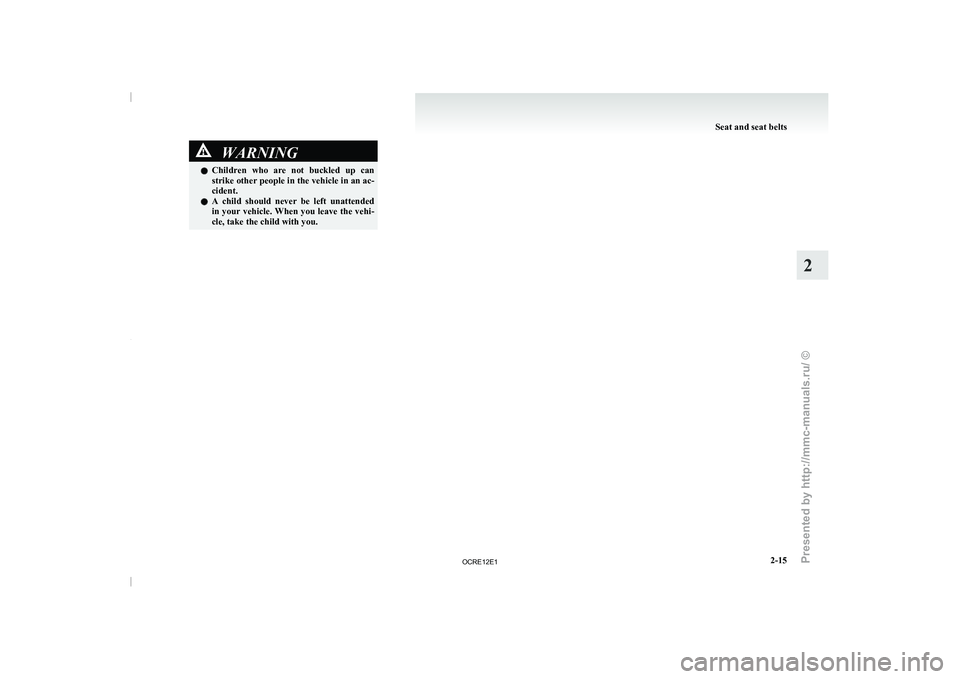
WARNING
l Children who are not buckled up can
strike other people in the vehicle in an ac-
cident.
l A child should never be left unattended
in your vehicle. When you leave the vehi-
cle, take the child with you. Seat and seat belts
2-15 2
OCRE12E1
Presented by http://mmc-manuals.ru/ \251
Page 61 of 369
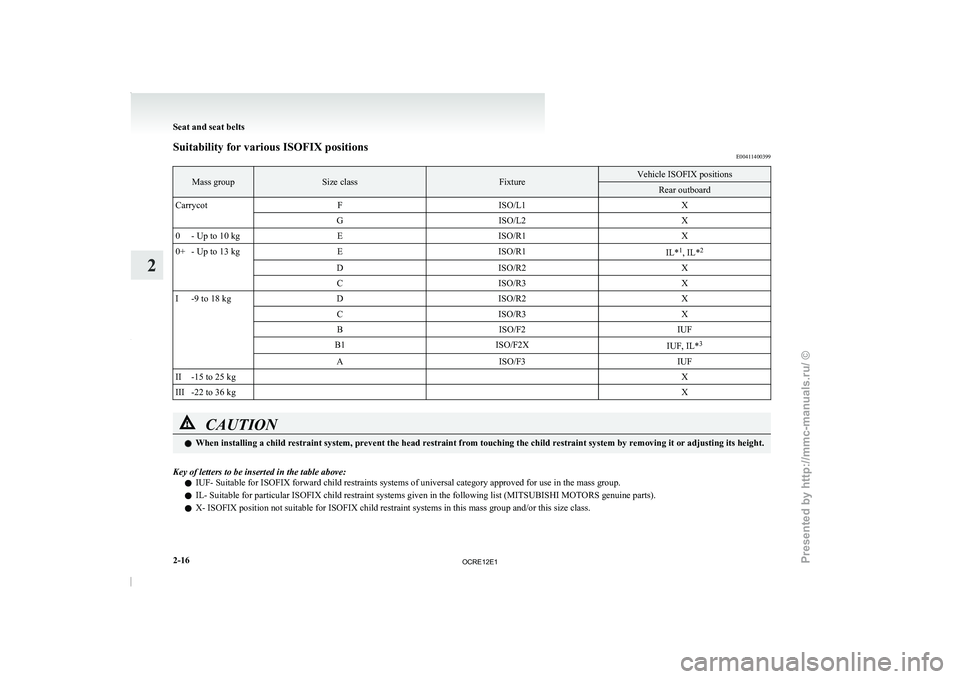
Suitability for various ISOFIX positions
E00411400399Mass group Size class Fixture Vehicle ISOFIX positions
Rear outboard
Carrycot FISO/L1 X
G ISO/L2 X
0 - Up to 10 kg EISO/R1 X
0+ - Up to 13 kg EISO/R1
IL*1
, IL* 2
D ISO/R2 X
C ISO/R3 X
I -9 to 18 kg D ISO/R2 X
C ISO/R3 X
B ISO/F2 IUF
B1 ISO/F2X
IUF, IL*3
A ISO/F3 IUF
II -15 to 25 kg X
III -22 to 36 kg XCAUTION
l
When installing a child restraint system, prevent the head restraint from touching the child restraint system by removing it or adjusting its height.
Key of letters to be inserted in the table above: l IUF- Suitable for ISOFIX forward child restraints systems of universal category approved for use in the mass group.
l IL- Suitable for particular ISOFIX child restraint systems given in the following list (
MITSUBISHI MOTORS genuine parts).
l X- ISOFIX position not suitable for ISOFIX child restraint systems in this mass group and/or this size class. Seat and seat belts
2-16
2
OCRE12E1
Presented by http://mmc-manuals.ru/ \251